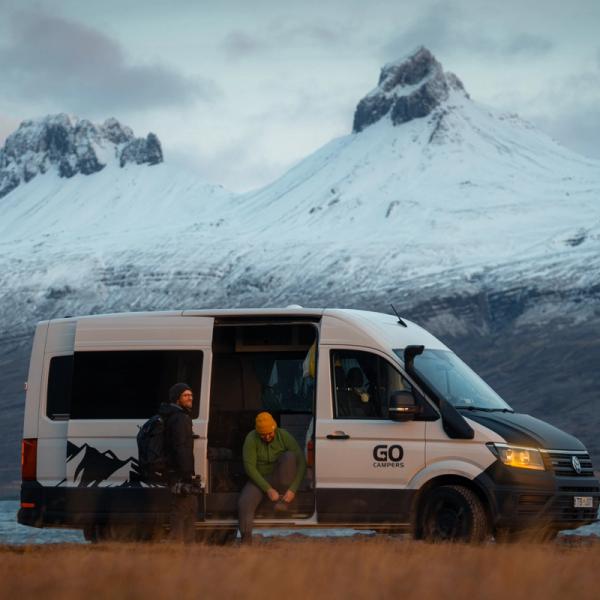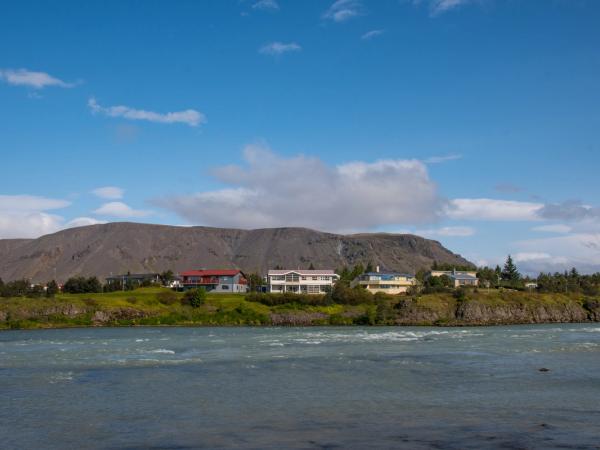
Discovering Selfoss, the most important city in South Iceland
One of the most complete and outstanding areas in Iceland is the Southern Region, known in Icelandic as Suðurland. There, the largest and most important city is Selfoss. This region is full of wonders, and there’s no better way to get to know it all than doing a road trip in a campervan. If you have your own vehicle, this place can be the perfect base: well connected by road, with many attractions within minutes, and many camping options for sleeping in your campervan. Located by the Ölfusá River, this charming town has a lot waiting for you.
Key Takeaways
- Selfoss is the largest city in South Iceland, Suðurland in Icelandic.
- The town is by the shore of the Ölfusá, a beautiful river.
- There are many camping grounds really close to the city.
Why is Selfoss worth a visit?
There is no single answer to that question, as Selfoss is a very attractive destination in many ways. But if we had to bring it down, then we would say as realtors do: location. This city in southern Iceland is the link between the southwest of the country, where Reykjavik and Keflavik International Airport are located, and the numerous natural wonders found in the southern region. If you’re doing a road trip through this part of the country, Selfoss is going to be one of the main references on your itinerary. But the city is much more than that.
Selfoss began as a farming hamlet and grew after the first bridge over the Ölfusá opened in 1891. That first structure was crucial to link the farms in the south of the country to the markets in Reykjavik, turning a quiet river crossing into a trade hub. The current concrete bridge, built in 1945 after the original collapsed, is part of the Ring Road (Route 1), Iceland's main road. The bridge is not only a key element in road traffic, but also a beautiful place that gives the town its postcard view.
Icelanders often call Selfoss the “capital of South Iceland” because it handles commerce for a wide rural area. It’s the largest city in the region in spite of having barely 10,000 inhabitants. It may seem small, but it’s a respectable size for this country. It has an active daily routine, yet it feels like a relaxed city, with beautiful streets and an awesome park by the river. The New Old Town project has restored more than thirty historic buildings, adding pedestrian lanes and small plazas without losing the original scale.
The name of the city means “Seal Falls,” although there are no waterfalls inside the town limits. There’s a waterfall in North Iceland with the same name, though, so be careful when entering the name on your maps app. There are, however, several close to the city, and some are among the best in Iceland. The river is worth a stop. It’s a quiet and beautiful area, and also a phenomenal spot for fishing. Salmon and trout swim upstream, especially in summer, and there are several spots for this activity. In winter, the water freezes in patches, creating natural ice sculptures against the lava-field backdrop.
We’ll get into more detail later about things to do and see in town, but if you’re doing a road trip through Iceland, Selfoss is a great base. It has all the services needed, including gas stations, supermarkets, bakeries, restaurants, and banks. Here, you can stop and restock, or sleep soundly before the next adventure.
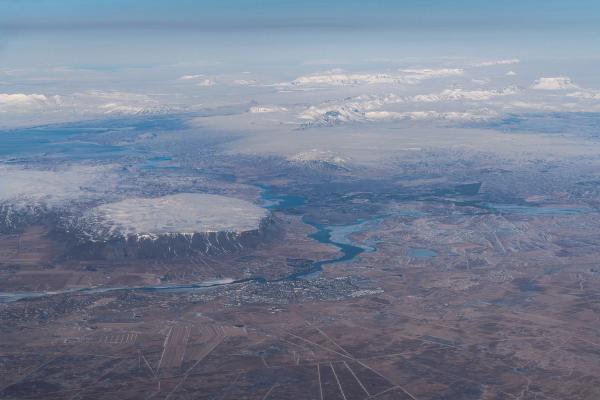
Where to eat in Selfoss?
If you’re planning on visiting or stopping at Selfoss during your trip, you’ll have plenty of options to eat out. Most of the places are close to the city center, which is located by the river, just after crossing the bridge if you’re coming from Reykjavik.
Kaffi Krús, on the main street, is a relaxed spot that serves casual yet well-prepared food, including salads, burgers, and pizzas baked in a stone oven. They also serve local craft beer. There’s a cool patio with wooden tables, perfect for days with good weather.
Mjólkurbúið Mathöll is an old dairy factory that has been turned into a market concept with eight food vendors under one roof. Pick Icelandic lamb soup from one stall, sushi from another, or a craft beer at the bar. It’s a great place to connect with fellow travelers or local neighbors, as the big tables are shared.
Not far from there is Byrja, a restaurant that serves breakfast all day. You can choose from skyr bowls with berries, avocado toasts, eggs in different ways, sausages, and much more, alongside a good cup of coffee.
Hot dogs are probably the most popular takeaway food in Iceland. Icelanders love them, and have given them a twist, bringing them closer to the traditional flavors of the country. Pylsuvagninn, just by the river, is a popular spot near the bridge, perfect for a cheap but substantial meal. Order the classic one “with everything” or opt for the deep-fried hot dog for a different twist. They also serve burgers.
Krisp Restaurant keeps things simple: fried chicken, burgers, and milkshakes. Simple doesn’t mean the quality is average; all the opposite, as Krips is owned and operated by Sigurður Ágústsson, a former member of the national culinary team. They also do takeaway if you prefer to eat in your van.
Tommi’s Burger Joint grills beef patties, and you can customize your order. The small dining room fills quickly at dinner, but ordering takeaway is a good option for a picnic by the river.
Lilly&Julia’s Kitchen focuses on local recipes with a modern twist. It’s nice and cozy, and the staff is lovely.
These are just a few options, but there are many more to choose from.

Where’s Selfoss and How to Get There
Selfoss is located in southwest Iceland, just 58 kilometers (36 miles) east of Reykjavik. The Ring Road (Route 1), the main road in the country that encircles the whole island, crosses the town. The trip from the capital is quite easy and straightforward. You just have to take the Ring Road for 45-55 minutes until you hit Selfoss.
Fuel and groceries are available in Selfoss, so no need to stock up earlier unless you prefer it.
There are also public services that run daily between Selfoss and the capital. However, once you get to Selfoss, you’ll need to rely on other methods to go and see all the natural marvels that are near the city, so having your own vehicle is the best option.
Where to stay near Selfoss
Gesthús Selfoss
Distance to town center: 1 km (0.6 miles). Open: Year-round.
This site offers three different types of accommodation: bungalows, summer houses, and camping area, with pitches for campervans and RVs with electric hookups. The camping area has restrooms, hot showers, free Wi-fi, a spacious dining room, laundry room, and a kitchen. There’s no need to book in advance, except when the Sumar á Selfossi festival is held.
Þrastalundur Camping
Distance to Selfoss: 10 km (6 miles). Open: Year-round.
A few minutes on the road north of Selfoss and you’ll get to this quiet camping ground situated in a beautiful forest. This place has restrooms, showers, cooking facilities, laundry room, and free Wi-Fi. They don’t take reservations, it works on a first-come, first-served basis.
Reykjamörk Hveragerði Campsite
Distance to Selfoss: 15 km (8.7 miles). Open: Year-round.
This camping ground is in the Reykjadalur Valley, an active geothermal area. It’s equipped with toilets, showers, communal kitchen, a BBQ area, washing machine and dryer, electricity hookups, and free Wi-Fi. Pitches are flat and divided by low hedges. A footpath leads to town in fifteen minutes, or drive five minutes to the grocery store. The on-site café sells coffee and waffles until 20:00.
Hraunborgir Camping Ground
Distance to Selfoss: 24 km (15 miles). Open: May to August.
Located in Grímsnes, this is a complete and family-friendly campsite. It’s close to the Golden Circle and has toilets with cold and hot water, electricity hookups, a laundry room, a swimming pool, hot tubs, and a restaurant that serves meals and drinks. The service center at the campsite offers access to several activities, including mini-golf, basketball, a playground, and a playroom.
Eyrarbakki Camping
Distance to Selfoss: 13 km (8 miles). Open: May to September.
Eyrarbakki is a quiet coastal town that has a camping ground. Close to black-sand beaches and with sea views, this campground offers cold and hot water, electricity, a laundry room, toilets, showers, and a children’s playground. It’s spacious and close to services in town.
Stokkseyri Camping Site
Distance to Selfoss: 14.5 km (9 miles). Open: mid-May to mid-September.
Stokkseyri is a small village known for its wild birdlife and breathtaking scenery. The campsite in town has grassy pitches, with the Atlantic just over the ridge. The facilities are clean and have recently undergone a refurbishment. It features toilets, showers, a laundry room, free Wi-Fi, a playground for children, a kitchen area, and hot tubs.

What to do in Selfoss and Nearby
Selfoss has developed more than other cities in the region primarily due to its location. The original settlement has grown and become an important cultural hub, with many activities to enjoy in town and its surroundings.
Visit the New Old Town
Wander through the restored and colorful timber buildings in the city center. The area is known as Miðbær Selfoss in Icelandic, mainly around Brúarstræti street. There you can also find several handicraft shops, with local specialties like wool sweaters and ceramic mugs. It’s just by Mjólkurbúið Mathöll, the old dairy factory turned into a food market. Most shops close by 18:00, leaving the streets quiet for an evening stroll.
Selfoss Swimming Pool
The local sundlaug has an 18-meter-long indoor pool, a 25-meter-long outdoor pool, a children’s pool with three water slides, a steam bath, a sauna, and hot tubs. There are four dressing rooms, two outside and two inside. It’s open daily until 21:00.
Fishing
The Ölfusá River running through town is a prime spot for salmon fishing in summer, with a short season from late June to early August. You can get permits in town, but fishing without one can result in high fines. Nearby rivers like Sog or Hólá add options for trout and char, easy to reach with your campervan.
Bobby Fischer Center
Born in the United States, chess master Bobby Fischer spent his last days in Iceland. In fact, he became an Icelandic national. There’s a small museum in Selfoss with an exhibition about him and some objects, like the chessboard from the 1972 world championship, which he won. There are panels that explain Fischer’s later years in Iceland. His grave is just north of the city, in the small town of Laugardælir, and is open to visitors.
Hellisskógur
Hellisskógur is a small forest 3 km (2 miles) north of Selfoss. It’s an excellent place for a short hike through birch and rowan trees. The trail to the sea cave takes twenty minutes round-trip; bring a flashlight to peek inside. There’s free parking at the trailhead.
“Sumar á Selfossi” Festival
If you’re coming in early August, you can enjoy the most popular cultural event that takes place in Selfoss. Sumar á Selfossi is four days of music, food stalls, and fireworks. The main street closes to traffic, and people set up picnic blankets in parks. The exact date changes every year.

What to see near Selfoss
Selfoss anchors South Iceland, a region packed with geological diversity, from craters to geysers. This area stands out for its mix of accessible sights along well-paved roads, perfect for campervan day trips. Within an hour's drive, you can cover highlights of the Golden Circle and South Coast, blending history, nature, and active volcanism.
Kerið Crater
Kerið Crater, located just 15 kilometers (9 miles) north of Selfoss, is a striking volcanic bowl formed around 3,000 years ago. In geological terms, that is quite young, and its shape is really well preserved, but it is extinct. The crater's walls are red and black, with an intense blue lake at the bottom, creating an astonishing contrast. There are two trails in the crater. One goes along the rim, with panoramic views of the surrounding landscape. The other one goes all the way down to the lake’s shore.
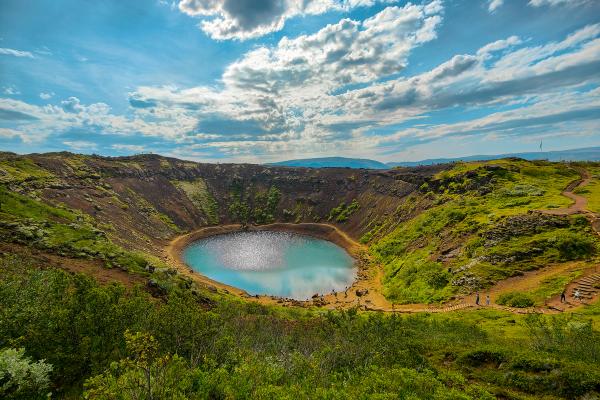
Hveradalir Geothermal Area
Geothermal activity is one of the main forces that has shaped Iceland and still does. Not far from Selfoss is one of the most active areas in this sense. The Reykjadalur Valley is home to Hveradalir, an area full of steaming vents, hot springs, and bubbling mud pots. There’s a path that goes through the area, allowing you to see the different elements. There are also natural hot baths with different temperatures.
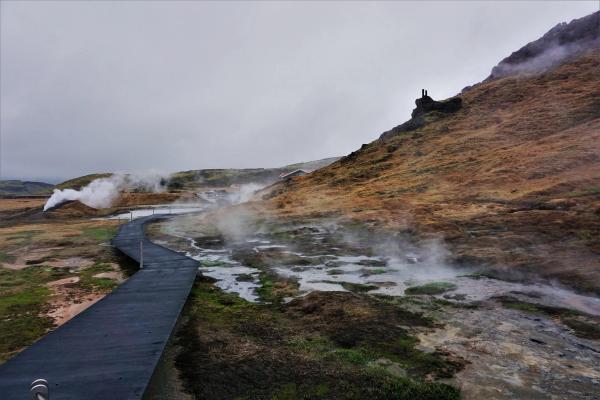
Seljalandsfoss
As we mentioned before, Selfoss means “Seal Falls,” but there are no waterfalls in town. Luckily, one of the most famous in all of Iceland is quite close. Seljalandsfoss drops 60 meters (197 feet) in a thin curtain. It’s powerful and beautiful, but its most distinctive feature is that it has a walking path that goes behind the water into a small cave. From there, you’ll have a quite unique point of view.
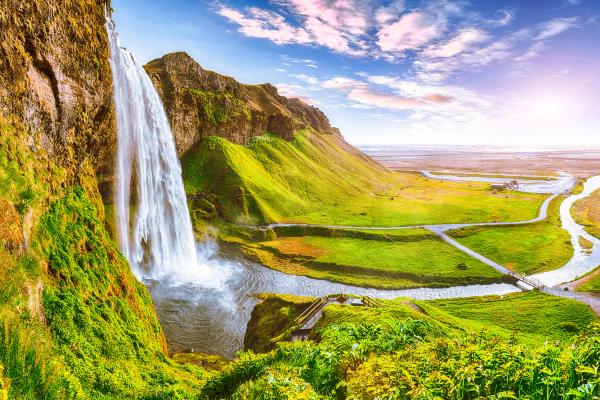
Gljúfrabúi
A couple of minutes on foot from Seljalandsfoss is another fantastic waterfall. Gljúfrabúi is a smaller cascade, about 40 meters (131 feet) tall, hidden inside a narrow gorge. To see it, you’ll need to wade through a shallow stream at the base of the gorge. At the end, a chamber opens up, where the water falls over mossy rocks into a quiet pond. It’s less visited than Seljalandsfoss, but the best experience here is to see them both.

Skaholt Cathedral
Skaholt, 40 kilometers (25 miles) north of Selfoss, marks a historic Christian center with roots in the 11th century, once serving as the seat of Iceland’s bishop and also an educational hub. The modern cathedral, built in the 1950s, has an exhibition about Iceland’s religious past and its role in shaping national identity. The remains of the old cathedral can still be seen.
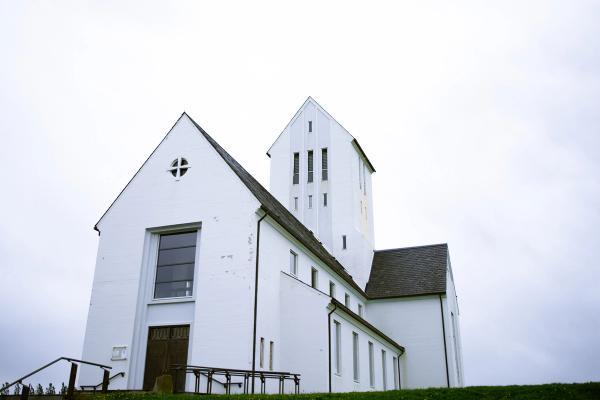
The weather in Selfoss
In Summer (June–August), the temperatures hover between 10 and 15 °C (50–59 °F). The days are really long, with almost 24 hours of natural light, giving you plenty of time for sightseeing. The weather is, in general, a mix of sunny spells and sudden showers. It’s the season with more tourists and campsites can fill fast, especially during the weekend.
Spring (April and May) and Autumn (September and October) are very similar weather-wise, but going in opposite directions. Temperatures range from 2 to 10°C (35-50°F), and it rains quite often. Many campsites are still closed in April and start closing by mid-September. On the other hand, they are the season with fewer tourists.
Winter (November to March) comes with temperatures often below freezing point and short days, barely four hours of light in December. The snow covers everything, and driving can be tricky. Many roads, especially secondary ones, close if the weather is bad. On a positive note, it’s the season when the Northern Lights happen.
What to pack to visit Selfoss
- Waterproof jacket and trousers for the sudden rain.
- Layered clothing (thermal base, fleece mid, waterproof outer).
- Sturdy waterproof hiking boots with ankle support.
- Swimsuit and travel towel for pools and hot springs.
- Reusable water bottle—Icelandic tap water is pure and safe to drink.
- Power bank. For long days out or campsites without electricity.
- Camping stove and basic cookware. Many camping grounds have cooking facilities, but some don’t. These can be rented with your campervan.
Travel Tips
- Fill up your tank in Selfoss. If you’re going to continue your trip, there are very few gas stations in rural areas or smaller towns.
- Supermarkets Bónus and Krónan close at 21:00.
- Stick to campsites, wild camping is illegal in Iceland.
- Check the road conditions before traveling to avoid unpleasant surprises.
- Reserve campsites or other accommodation months in advance if you’re coming in early August, when the Sumar á Selfossi festival is held.
- Drive with headlights on at all times; it’s mandatory.
- Pack groceries for one day ahead; remote sites have no shops.
Conclusion
Selfoss is one of the most attractive and vibrant cities in Iceland. It may seem small in other countries, but it’s a place full of charm. Its location, not far from Reykjavik and close to some of the best natural monuments in the country, makes it a phenomenal base to explore South Iceland. The food scene is great, the surroundings are beautiful, and you have plenty of options to sleep close with your campervan.

